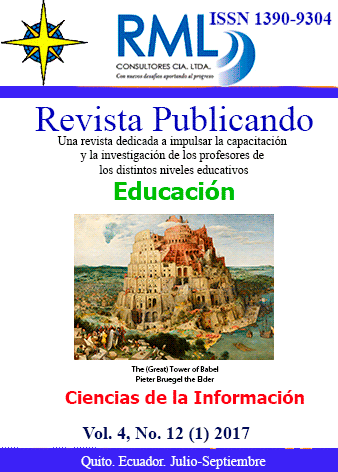Resumen
Reading plays an important role in second language learners”™ academic achievement for many reasons. That”™s why understanding some important facts about reading instruction for teachers is essential to providing effective instruction in reading.
The aim of this paper was to make an analysis of different studies on the research findings and issues about using graphic organizers as a mainly used as a reading strategy. It highlights key concepts from reading research, reading second language, methods and approaches for teaching EFL, reading strategies, reading skills and the theoretical foundations of graphic organizers. Teachers play an essential role in helping students to increase their ability in reading comprehension. Students can use visual organizers as a support when interacting with peers in cooperative learning environments to learn more effectively as they have more significant understanding of what is being read. Additionally, students recall more central ideas when they learn from a graphic organizer than when they learn from a text. (Angela M. O”™Donnell, Donald F. Dansereau,Richard H. Hall, 2002)The methodology used was based on a descriptive study through the analysis of several primary sources such as research papers on the topic that have been published in scientific journals, books among others. We can conclude by saying that there were great benefits from using graphic organizers as an instructional tool. Teachers should start implementing t this reading strategy in their classrooms and train students in using it as effective readers to develop their reading comprehension abilities and to promote their autonomous learning and attain higher levels of performance. Graphic organizers are valuable tools in teaching students how to become better readers and thus better learners. However, there have not been enough studies related to the topic. This study will stimulate further research and thinking about the use of graphic organizers as a reading strategy.
Referencias
Angela M. O”™Donnell, Donald F. Dansereau,Richard H. Hall. (2002). Knowledge Maps as Scaffolds for Cognitive Processing. Educational Psychology Review, 1-16.
Ausubel, D. P. (1960). The use of advance organizers in the learning and retention of meaningful verbal material. Journal of Educational Psychology., 267-272.
Bernhardt, T. M. (2010). Using graphic organizers to enhance reading comprehension . California: University of California.
Brown, H. D. (2000). Teaching by principles An interactive Approach to Language Pedagogy. New York : Pearson.
Condidorio, K. (2010). The Usefulness of Graphic Organizers in Enhancing Science Learning. Fisher Digital Publications, 1-30.
Ching, k. L. (2015). The Use of EFL Reading Strategies among High School Students in Taiwan. The Reading Matrix: An International Online Journal, 156.
Freeman, D. L. (2010). Techniques and Principles in Language Teaching . London : Oxford.
Harestad, M. (2010). Teaching reading in EFL instruction. En M. Harestad, Teaching reading in EFL instruction (pág. 93). Oslo: Universitetet i Oslo.
Harmer, J. (2010). How to teach English. China: Oxford Publishing.
J. C. Alderson; A. H. Urquhart. (1986). Reading in a foreign language. TESOL Quarterly, 747-751 .
Kiebra, D. R. (1995). Visual Argument: Graphic Organizers are superior to Outiles in Improving learnig from a text. Journal of Education Psychology, 455 -467.
Kintsch, W., & Rawson, K. A. (2005). Role of rhetorical structure in text comprehension. Journal of Education Psychology, 828- 824.
Kuo-En Chang,Yao-Ting Sung,Ine-Dai -Chen. (2002). The Effect of Concept Mapping to Enhance Text Comprehension and Summarization. The Journal of Experimental Education, 5-23.
Kyu-Cheol, S. (2013). Developmental Approaches to the Teaching of EFL Reading. Pan-Pacific Association of Applied Linguistics, 160, 161.
Mohammad PÄ°RÄ° ARDAKANÄ°1, Anita LASHKARÄ°AN. (2015). Using Mind Mapping Strategy to Improve Reading Comprehension Ability. Science Joural, 1175-1798.
Polyxeni Manoli, Maria Papadopoulou. (2012). Graphic Organizers as a reading strategy:. Scientific research , 348-356.
Praveen Sam D, P. R. (2013). Using graphic organizers to improve reading comprenhension skills for the Middle EFL students . Candian Center of Science and Education , 155.
Rajan2, P. S. (2013). Using Graphic Organizers to Improve Reading Comprehension Skills. English Language Teaching.
S.Jay Samuel, Alan E. Farstrup. (2011). What research has to say about reading instruction . 51-75: International Reading Association .
Tomlinson, C. A. (1999). Mapping a Route Toward Differentiated Instruction. Educational Leadership, 12-16.
Tracey Hall, Nicolle Strangman. (2008). Gaphic Organizers. Walch Education , 1-10.
Xiangying Jiang and William Grabe. (2007). Graphic organizers in reading instruction: Research findings and issues. Reading in a foreign language, 34-55.
Zare, P. (2012). Language Learning Strategies Among EFL/ESL Learners. International Journal of Humanities and Social Science, 18.
Usted es libre de:
Compartir — copiar y redistribuir el material en cualquier medio o formato
Adaptar — remezclar, transformar y construir a partir del material
La licenciante no puede revocar estas libertades en tanto usted siga los términos de la licencia
Bajo los siguientes términos:
Atribución — Usted debe dar crédito de manera adecuada, brindar un enlace a la licencia, e indicar si se han realizado cambios. Puede hacerlo en cualquier forma razonable, pero no de forma tal que sugiera que usted o su uso tienen el apoyo de la licenciante.
NoComercial — Usted no puede hacer uso del material con propósitos comerciales.
CompartirIgual — Si remezcla, transforma o crea a partir del material, debe distribuir su contribución bajo la lamisma licencia del original.
